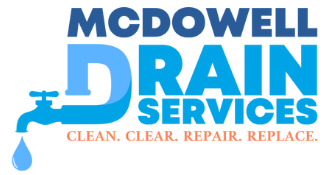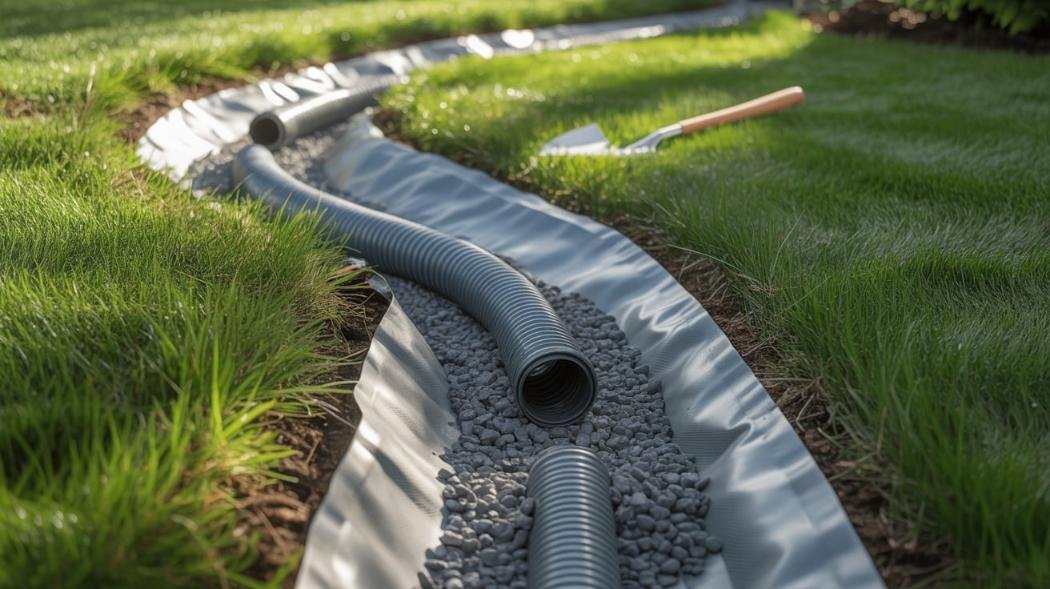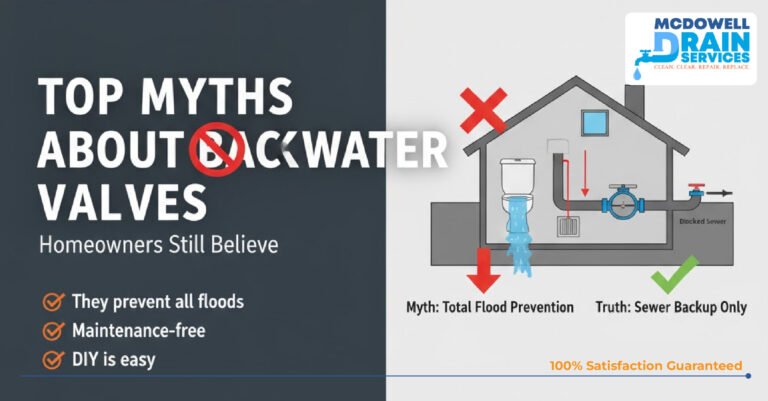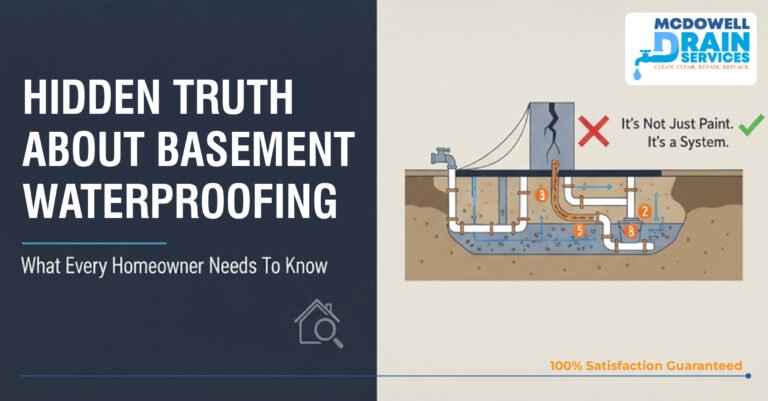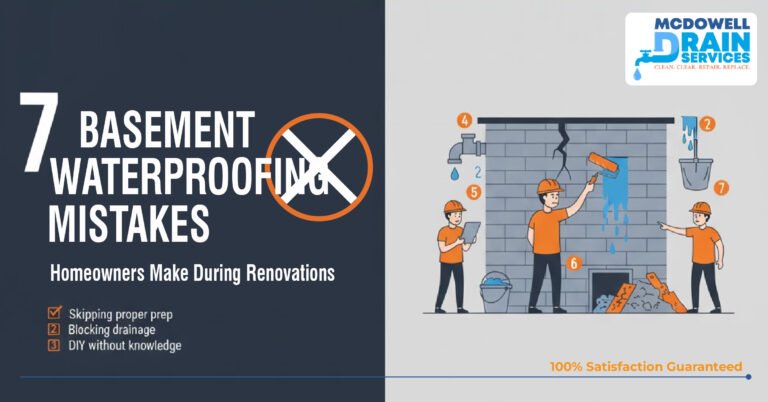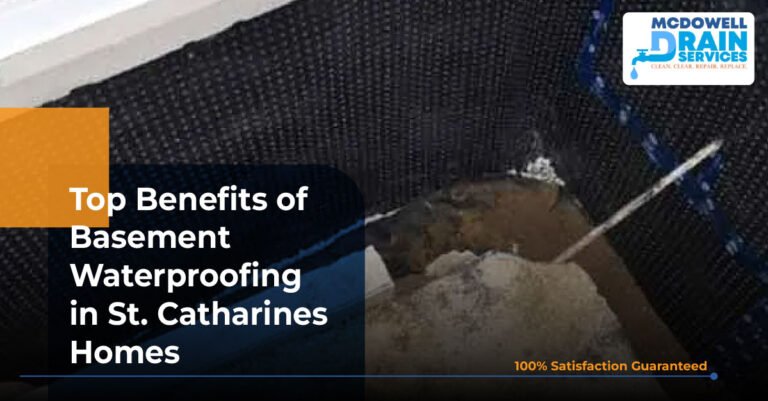Introduction
Every time it rains, does your lawn turn into a muddy mess? Or maybe your basement starts to smell damp?
If that sounds familiar, you’re not alone. Homeowners in Niagara Falls areas like Chippawa, Stamford, Lundy’s Lane, and Downtown Niagara Falls deal with these same water issues all the time. Homeowners from the nearby cities like Welland, St. Catharines, Thorold, and Niagara-on-the-Lake face them too.
The good news is, there’s a simple fix that actually works. It’s called a French drain.
In this blog, we’ll break it all down. You’ll learn what a French drain is, how it compares to other drainage systems, what it costs, and whether you can install one yourself.
After all, rain is about to enjoy, not to stress about.
You should read: Clogged Drain Cleaning in Niagara Region: McDowell’s Proven Solutions That Work
How Does French Drain Work?
A French drain works by moving water away from your home using a gravel-filled trench with a pipe at the bottom. When water builds up in the soil, it flows into the trench, then into the pipe, and gets carried safely away, usually to a storm drain or low-lying area. It helps keep basements and foundations dry by reducing pressure from groundwater around your home.
What Are the Steps to Install a French Drain?
- First, we assess your property—where water pools and where it should exit.
- Then we dig a trench, typically 6–12 inches wide and 18–36 inches deep depending on your land.
- We lay landscape fabric to prevent soil from clogging the system.
- Add a gravel base, then place a perforated pipe (with holes facing downward) to collect water.
- Top the pipe with more gravel and wrap the fabric over it like a burrito.
- Backfill the trench with soil or sod—it’ll look like nothing happened, but your new French drain system will silently do its job underground.
McDowell does this with precision and care, ensuring your drain works for years to come.
How Deep Should a French Drain Be in Canada?
- Most French drains in Canada are buried 18 to 24 inches deep to handle typical water flow.
- In colder regions like Thorold or Niagara-on-the-Lake, we often go deeper (up to 36 inches) to stay below the frost line.
- For foundation protection, the pipe needs to sit below your basement slab or footing.
- Don’t forget slope—it’s not just depth. A 1% slope (1 foot drop over 100 feet) is key to keeping water moving.
- At McDowell, we calculate the perfect depth and slope for your unique property—so your French drain installation won’t fail in February.
What Are the Downsides of a French Drain?
- Let’s say you’ve got a beautifully landscaped backyard—installing a French drain system will require trenching through it, which may temporarily disrupt your yard.
- In cold Canadian winters, if the drain isn’t buried deep enough, water inside the pipe can freeze and block the system—usually when you need it the most.
- Over time, poor design or missing fabric can lead to clogs from tree roots or compacted soil.
- Upfront French drain installation costs can be higher than expected, especially with deeper trenches or large-scale setups.
- But here’s the thing: with McDowell Drain & Waterproofing, you avoid all these headaches—we plan for slope, climate, and long-term performance from day one.
When You Shouldn’t Install a French Drain System
Believe it or not, sometimes a French drain just isn’t the hero your home needs.
- Let’s say your basement is flooding, but it’s actually your sump pump that failed or your downspouts are dumping water right at your foundation. Digging a trench won’t solve that.
- Trenching may not be possible in tight spaces or properties packed with roots or underground utilities.
- In areas with dense, compacted clay soil, water may not filter down to the pipe at all—making the system ineffective.
- Sometimes better solutions include surface regrading, sump pumps, or internal waterproofing.
This is why at McDowell Drain & Waterproofing, we never jump to French drains first. We listen to your home’s story, inspect everything, and only recommend what’s truly best. Sometimes that’s a French drainage system—sometimes it’s not. Either way, we’ve got you covered.
What is the difference between a weeping tile and a French drain?
Homeowners often ask us: “What’s the difference between weeping tile and a French drain? Aren’t they the same thing?” The answer? They’re similar in purpose—but different in design and placement. And knowing when to use each can make or break your waterproofing plan.
French Drain System:
- A French drain is usually installed at the surface or just below ground level, around yards, driveways, or slopes.
- It collects surface water or shallow groundwater before it reaches your foundation
- Ideal for: wet yards, water pooling in gardens, or managing water runoff away from your home or garage.
- Easier and less invasive to install in open landscapes.
Weeping Tile System:
- Weeping tile is a type of perforated pipe system installed along your home’s footing, either internally (inside the basement wall) or externally (around the foundation).
- Its job is to catch groundwater before it pushes into your foundation or basement.
- Ideal for: homes with basement water issues, hydrostatic pressure, or foundation seepage.
- More complex to install—often part of a larger basement waterproofing system.
So, when should you use which?
- Use a French drain when:
- Your yard is soggy or unevenly graded
- You’re dealing with surface water or runoff
- You want to redirect water away from your home, garage, or driveway
- Your yard is soggy or unevenly graded
- Use a weeping tile system when:
- You have water leaking into your basement
- You see signs of foundation moisture, cracking, or musty smells
- You need full-scale foundation waterproofing
- You have water leaking into your basement
At McDowell Drain & Waterproofing, we help you choose the right system—or even combine both—based on your property’s unique drainage challenges. Because in Niagara’s wet weather, one size never fits all.
Which is the Best Drainage System?
In Niagara Falls, where the soil is often heavy clay and we see a mix of snow, rain, and freeze-thaw cycles, a French drainage system is usually the best choice. It’s designed to move water away from your home’s foundation and yard, which helps prevent flooding and water damage. Whether you live in the Downtown Core or Clifton Hill, this system works great with the local terrain. If you’ve just googled drainage companies near me or French drain installation, this is likely the solution your property needs.
Also read: 5 Warning Signs You Need Hydro Jetting Services in Welland
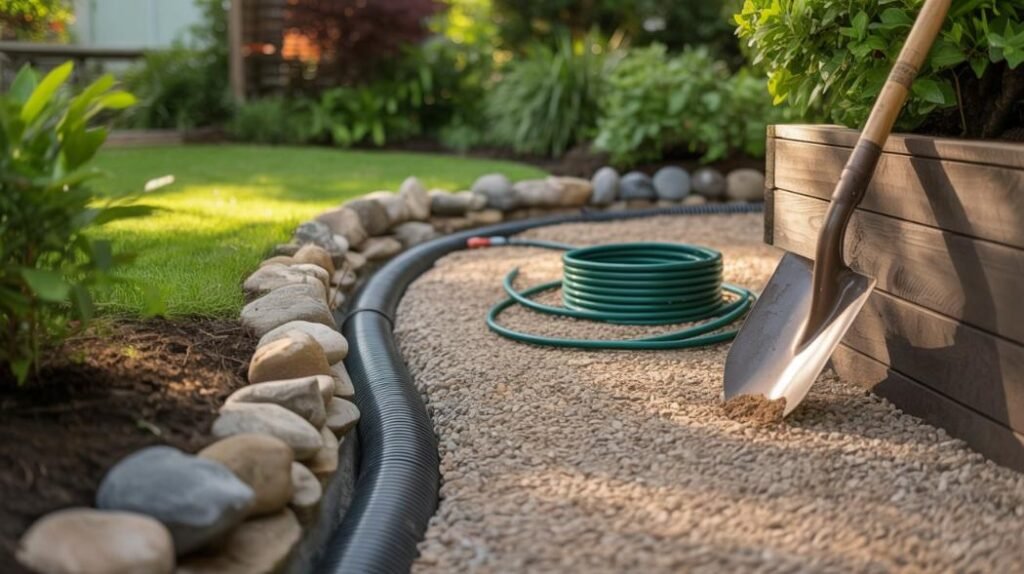
French Drain vs. Other Drainage Systems: Which One Is Right for You?
Not every drainage issue needs the same fix. If you live anywhere in the Niagara Falls, the right system depends on where the water is building up and what type of soil you have.
Here’s a comparison table to help you understand better:
| Drainage System | Best for | Lifespan | Maintenance Level | Fit for Niagara Homes |
| French Drain | Waterlogged yards, leaky basements | 30+ years | Moderate | Great for clay-heavy soil and sloped yards |
| Surface Drainage | Puddles on flat areas or hard surfaces | 10–20 years | Low | Good for newer subdivisions and driveways |
| Sump Pump System | High water table or interior water seepage | 10–15 years | High | Works well in older homes and low-lying spots |
| Gutter Extensions | Roof runoff pooling near foundation | 10–15 years | Low | Ideal for homes with short downspouts or poor grading |
Still scratching your head over the right fix? Sit back and relax, let us, McDowell Drain & Waterproofing take the guesswork out based on your specific layout.
Give us a call now!
How Much Will it Cost to Install a French drain?
Wondering what it’ll cost to keep your yard dry for good? In most parts of Niagara, a French drain system can cost anywhere from $2,000 to $12,000, but it really depends on your property and other factors.
What affects the price?
- How deep and long the trench needs to be
- Whether it’s for your yard or basement
- Type of soil (clay makes the job tougher)
- How much slope your yard already has
- Equipment access in tight spaces
It might not be for you if:
- Your yard is completely flat with no slope
- There’s no safe place for water to drain
- You’re only dealing with light surface puddles
- You want a quick, low-budget solution
Not sure if it’s the right fit? McDowell Drain Solutions can take a quick look and let you know what works best, no pressure, just honest advice.
You can check out our rebate page for more relaxation!
Where not to put a French drain?
A French drain system works best when water can flow away easily. If your yard is flat with no slope, the water may not move at all. It is also not a good idea to put a French drain where the water has no safe place to go. Never install one near gas lines, septic tanks, or sewer pipes. In cold areas like parts of Pelham or Thorold, the drain should be deep enough to avoid freezing. If you are not sure your yard is a good fit, McDowell Drain Solutions can check it for you.
Can I do a French drain myself?
Yes, you can try to install a French drainage system yourself. You will need to dig a trench, make sure it slopes, lay the pipe, cover it with gravel, and wrap it with special fabric. If your yard is easy to dig, like in Welland or Virgil, it may be a good DIY project. But if the ground is hard or the area is too small, it can be very hard to do. Even small mistakes can cause big water problems later. If you are not sure, it is safer to ask McDowell Drain Solutions for help.
Why the Government Says Good Drainage Matters in Niagara
The Niagara Peninsula Conservation Authority (NPCA) says many homes in areas like Stamford, Chippawa, and Thorold are at risk of flooding. That’s because the ground here is mostly heavy clay, and when it rains or snow melts, water doesn’t drain well. The NPCA uses specialized maps to indicate where floods are most likely to occur.
This is why a system like a French drain can really help. It moves water away from your home before it causes damage. It’s not just a smart fix, it’s a proven one backed by local experts.
Official source: NPCA Floodplain Mapping (npca.ca)
No More Backyard Swamp: How Amanda Got Her Yard and Basement Back
Amanda, a homeowner in Stamford, Niagara Falls, had a backyard that flooded every time it rained. Water would sit near her porch and even leak into her basement. She called McDowell Drain Solutions, and after a quick visit, they installed a French drain system along the back of her yard.
It was done in two days. The next storm came, and everything stayed dry, no more puddles, no more basement leaks.
Amanda shared, “McDowell made it easy. They fixed the problem fast, and now I don’t worry when it rains.”
Want to see more stories like Amanda’s? Check our reviews here.
FAQs
1. How can I improve the drainage on my property?
You can improve drainage by grading the yard away from your home, adding downspout extensions, or installing professional solutions like French drains and sump pumps from McDowell Drain Solutions.
2. Do French drains require maintenance?
Yes, French drains do require maintenance. McDowell Drain Solutions recommends periodic checks and cleaning to prevent clogging from debris or sediment buildup.
3. What causes recurring drain clogs in Niagara homes?
Tree roots, grease buildup, aging pipes, and poor drain design commonly cause recurring clogs in Niagara homes.
4. Can French drains handle heavy rain?
Yes, when properly installed by professionals like McDowell Drain Solutions, French drains can efficiently handle heavy rain and prevent water pooling.
5. How do I find the best-rated drainage company near me?
Look for top-rated drainage companies by checking Google reviews, HomeStars ratings, and customer testimonials for proven expertise and satisfaction.
6. Do I need a permit to install a French drain in St. Catharines?
Yes, in St. Catharines, you may need a building permit to install a French drain, especially if it alters water flow, connects to municipal systems, or affects neighboring properties.
7. Can I install a French drain myself, or should I hire a professional?
No, it is not advisable to install a French drain yourself. Hire trusted professionals like McDowell Drain Solutions to ensure proper slope, drainage, and long-term effectiveness.
